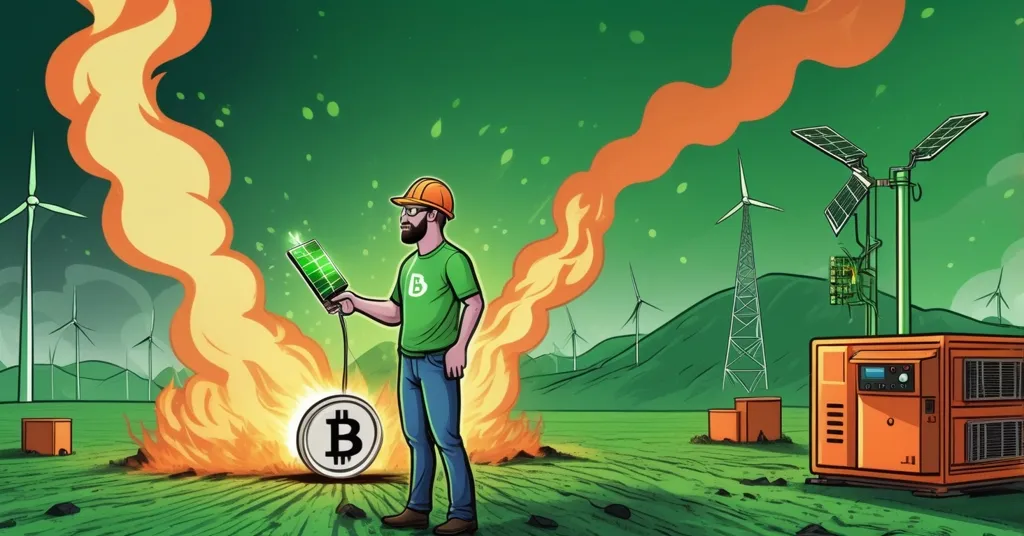Sen. Ted Cruz’s FLARE Act: Boosting Bitcoin Mining with Stranded Gas

Sen. Ted Cruz Introduces FLARE Act to Boost Bitcoin Mining with Stranded Gas
– FLARE Act encourages Bitcoin mining with stranded gas
– Tax incentives offered to reduce emissions
– Political opposition expected from Democrats
Senator Ted Cruz has introduced the FLARE Act, a bill designed to incentivize Bitcoin miners to utilize stranded natural gas for their energy needs. Stranded gas, which is natural gas that is not economically viable to transport or use due to its remote location, would be repurposed under this legislation. The FLARE Act aims to align the crypto industry’s growth with environmental sustainability by offering tax incentives to miners who convert this otherwise wasted resource into power for digital asset mining.
The FLARE Act, or Facilitating the use of Low-cost and Renewable Energy (FLARE) Act, proposes permanent tax incentives for companies that use stranded gas to power their digital asset mining centers. Senator Cruz believes this could position Texas as the leading hub for Bitcoin mining in the U.S. “I am committed to making Texas the number one place for Bitcoin mining. The FLARE Act incentivizes entrepreneurs and crypto miners to use natural gas that would otherwise be stranded,” Cruz stated.
Hailey Miller, Director of Government Relations & Public Policy for The Digital Power Network, supports the initiative. “Bitcoin miners are uniquely positioned to help reduce emissions by harnessing stranded and wasted energy sources,” she said. Miller also emphasized the broader benefits, noting, “The FLARE Act ensures that American energy producers have the tools to deploy cutting-edge solutions that make our energy markets more efficient and resilient.”
Bitcoin mining, the process of verifying transactions and adding them to the public ledger, requires significant computational power and energy. The FLARE Act offers a 30% tax credit for companies that use stranded gas for mining, potentially saving them millions in operational costs. This could revolutionize Bitcoin mining by utilizing stranded gas, potentially reducing the environmental impact of crypto mining.
However, not everyone is on board with this plan. Critics argue that while the FLARE Act aims to reduce emissions by repurposing gas that would otherwise be released into the atmosphere, it might not be the silver bullet it’s made out to be. The crypto mining industry already accounts for 2% of global electricity use and nearly 1% of global emissions, according to the International Monetary Fund. Moreover, the energy consumption of a single Bitcoin transaction is staggering, equivalent to what a person in Ghana or Pakistan uses over three years. Critics are calling the FLARE Act a ‘greenwashing gimmick’ that won’t do squat to reduce the crypto industry’s massive carbon footprint.
Opposition to the FLARE Act is expected from Democratic lawmakers, with Senator Elizabeth Warren leading the charge for more stringent reporting of energy and emissions from crypto miners. Critics also worry about the potential impact on local energy distribution and costs, questioning whether the bill truly aligns with broader environmental goals. While the FLARE Act aims to reduce emissions from stranded gas, some experts argue that it might encourage more mining, ultimately increasing overall energy consumption. The debate over the environmental impact of the FLARE Act continues to be a hot topic.
If enacted, the FLARE Act’s policies would take effect at the start of 2026, setting the stage for a new era of energy-efficient Bitcoin mining. However, the bill’s future hinges on political support, with the crypto industry’s environmental footprint remaining a contentious issue. The political support and opposition to the FLARE Act will be crucial in determining its fate.
As we navigate the complexities of this legislation, it’s clear that the FLARE Act represents a bold attempt to align the interests of the crypto industry with sustainable energy practices. Whether it will succeed in reducing emissions while boosting Bitcoin mining remains to be seen, but one thing is certain: the debate over the environmental impact of digital assets is far from over. If the FLARE Act passes, it could set a precedent for other countries to follow, potentially transforming the global energy landscape. The benefits and concerns of the FLARE Act are still being discussed widely.
Key Takeaways and Questions
– **What is the FLARE Act and its main purpose?**
The FLARE Act, introduced by Senator Ted Cruz, aims to encourage the use of stranded natural gas for Bitcoin mining by offering tax incentives, with the goal of reducing emissions.
– **How does the FLARE Act propose to reduce emissions?**
By converting stranded natural gas, which would otherwise be released into the atmosphere, into energy for digital asset mining operations.
– **What are the potential benefits of the FLARE Act?**
The FLARE Act could enhance energy efficiency, support the crypto industry, and reduce emissions by repurposing wasted gas.
– **What concerns have been raised about the FLARE Act?**
Critics are concerned about its environmental impact and potential effects on local energy distribution and costs.
– **When would the FLARE Act take effect if passed?**
The policies of the FLARE Act would take effect at the start of 2026 if enacted.
– **Who supports the FLARE Act?**
Senator Ted Cruz and Hailey Miller from The Digital Power Network support the FLARE Act.
– **Who opposes the FLARE Act?**
Democratic lawmakers, including Senator Elizabeth Warren, are expected to oppose the FLARE Act due to different environmental priorities.
– **What is the current environmental impact of crypto mining?**
Crypto mining accounts for 2% of global electricity use and nearly 1% of global emissions, with one Bitcoin transaction consuming as much energy as a person in Ghana or Pakistan uses over three years.



